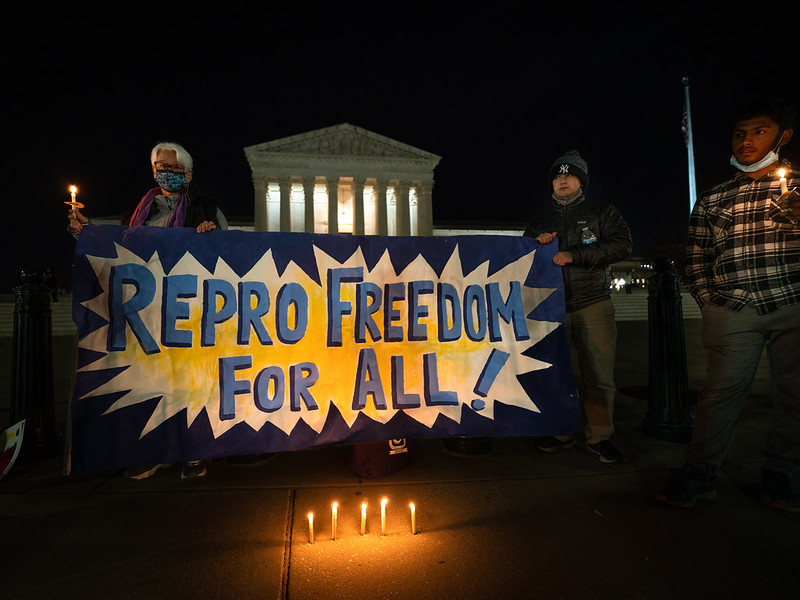The right has made their move, with six of nine Supreme Court Justices, including three Trump appointees, serving for a lifetime on an unelected body, determining what people can and cannot do with their own bodies. If this isn’t a signal of the ascendance of the right, a qualitative shift in the balance of forces, then what is?
Since the moment Roe was legalized, the right has built their forces and their ideas—which had been made ideologically unpalatable by the civil rights movement and the struggles against oppression it unleashed. The right has used a strategy of targeting abortion clinics, providers, and patients, pairing right-wing vigilantism against abortion with a legislative focus in particular states, and by combining its street movement with political power. Their hard work has come to fruition. This is not a hiccup, or a momentary break in the arc of history marching towards justice, and it puts the tasks of the Left into urgent perspective. The Left is in a weak position in the face of the ascendant right, and it must be rebuilt.

In our rebuilding, the unapologetic defense of bodily autonomy, abortion access as a human right, must be at the center of our project against the right wing’s full-frontal attacks. And doing so means thinking seriously about our demands and our targets if we are to regain lost ground, let alone advance beyond the limitations of Roe itself.
The majority on the Supreme Court made their ruling on the basis that the constitution is silent on abortion, and therefore it is not legally protected under federal law. The ramifications of this decision are immediate. Eight of 13 states with trigger laws set to go into effect if Roe went down have banned abortion outright, with clinics canceling procedures and people seeking abortion fearing for their futures. The New York Times podcast ran chilling interviews with abortion providers who were forced to call hundreds of people to tell them that they no longer had appointments. Another ten states are seeking severe restrictions imminently.
We’re right back to the states’ rights arguments that were used to justify slavery, and later Jim Crow, before the Civil Rights movement. Now, states will fight it out in the legislative sphere—is abortion to be legal? Will doctors and nurses lose their licenses if they continue to provide abortions? (And if provided, how will medical care be impacted?) Will people be criminalized and bounties offered for anyone who provides information on someone asserting their bodily autonomy “illegally”? Will people break the law publicly and loudly, or is the fear and threat too much for people to bear?
A new generation in the United States is about to live through the consequences of abortion bans. Bans that we know will not stop people from seeking out abortions when they don’t want to be pregnant. Even in the least bad outcomes, these bans will mean deaths, infections, criminalizations, and differential access to care for wealthy abortion seekers over the poor, with people of color being disproportionately impacted. We don’t have to look to the pre-1973 history for this evidence. Look at any country in the world today where abortion access is curtailed: unsafe abortion is a leading cause of death, a state-sanctioned public health crisis.
It is true that we now have potential access to more medical forms of abortion, like the abortion pill—first used in 1979—and misoprostol – an NSAID used for treating ulcers that were discovered to terminate a pregnancy safely at certain doses. These are overall much safer than backalley surgical abortions, and could potentially be distributed and procured more easily. Indeed, many networks have developed to make these available through the mail and through new virtual medical start-ups. Abortion funds help provide money to people who now need to travel. Newly former abortion providers are helping people get appointments across state lines.
These emergency responses are critically important and must be paired with demands at the state and national level. We can expect more people to seek DIY and backalley abortions out of fear, even though the technology exists to prevent this. The legality of aiding and abetting people to get abortions—whether by mail or car or underground—is going to be called into question. Attempts will be made to instill fear and threaten criminal action against people providing this help. In this context, mutual aid and individual assistance is a political act. The more we can do it publicly and in open defiance, the more it can be visible and given credibility, which is hard to do in the context of states that are pursuing criminalization. But the more our response can be seen the better, lest we retreat to individualized misery and an unacceptable acceptance of the new status quo.
While lives lost and human suffering is the most acute outcome of abortion bans, the impact of this decision will be much more far-reaching. The far-right worldview rests on the restoration of “traditional” gender roles, which means women belonging to their husbands and trans/non-binary people’s existence being under attack. It is linked to a nationalist ideology that is built on othering, defending the nation-state and scapegoating racial, religious, and ethnic groups, as well as “woke” people who want to be able to express a varied form of gender identity, for economic and social problems. It is a politics of minority rule and subjugation.
There is a reason why every far-right project in the world has curtailing abortion as a central plank of their program. It’s tied to controlling birth rates, producing more workers—and thus more competition between workers—but also an increased reliance on privatized social reproduction of children. This helps explain the blatant contradiction between the pieties for the fetus versus the care and attention given to its actual future life.
The same people who oppose abortion frequently support viciously racist, xenophobic, anti-working class agendas, promising greater misery when a fetus develops into a human. Restrictions on bodily autonomy do not solely impact individual choices, they affect the entire social sphere. We need to understand reproductive rights—from abortion, to pre-natal care, to social services, to school funding, to access to a living wage and socialized childcare, to not being forced to give birth while shackled in prison— as part of a larger social context and part of a larger worldview, contested between the right and the Left.
And yet, despite the calamity that has been unleashed by the Dobbs decision, and the precedent it sets for undermining the rights to same-sex marriage, gender autonomy, protections against sexual violence, and more, it is true that the majority of people in the United States—61 percent—believe that abortion should be legal, compared with only 46 percent when Roe v. Wade was decided in 1973. Here, we get to the meat of the strategy question, about what we are going to do to reverse this attack, and how.
First, while support is an indicator of what is possible, in the absence of mobilizations, struggles, strikes, and movements, it has no bearing on public policy. And we should not kid ourselves, public opinion does not hold forever. If fewer people supported Roe 49 years ago, then it’s possible that public opinion will shift back as the abortion bans are “normalized.” Of course, this will be tempered by the lived reality of what it means for abortion access to be curtailed, and the development of new organizing and struggles in the wake of the new balance of forces. But public opinion alone cannot change the reality of minority rule.
We need to understand that there is a reason why the right has been so able to utilize the institutions of the state in ways that the Left has not been successful in doing. They seek minority rule in a constitutional system set up to defend minority rule, to protect against actual democracy. And their policies fit very well with a ruling class, and minoritarian agenda, whereas socialized medicine, for example, does not.
Whatever tactics we develop in this terrible new moment, we need to be honest and clear about the fact that the institutions of this country are rigged against us. The system is broken by design. In this context, what kind of solutions can be delivered from on high? With the court stacked as it is, with the Democrats opportunistic, mealymouthed, and divided—in the service of its own ruling class base—, what reform can be made within the existing structures of the state to secure abortion rights once again? Even if the Democrats try to pass legislation, could it be upheld without a serious ground game with Clarence Thomas pledging his revenge?
We need to reject any illusions of a short-term fix. This is a generational battle. The starting point needs to be overturning the existing constitutional order, like they did in Chile, and like the Civil Rights, Abolitionist, and Suffrage movements in this country did in previous centuries. From there, let’s talk about what tactics, and next steps and infrastructures of dissent can be built around immediate campaigns and demands. Perhaps AOC’s calls for the impeachment of Kavanaugh and Gorsuch could positively contribute to the rebuilding of a national movement to take up these issues, but all tactics have to be weighed against the illusion that there is a short-term, institutional fix in this undemocratic hellscape.
We can only build what is needed if we focus on what is required for the long term. Legislative, and electoral strategies have not worked to defend abortion access. We need a long-term strategy based on building and sustaining mass resistance, and an alternative to the liberal dominated reproductive rights movement.
Consider this: the emergency demonstrations in response to Dobbs felt a lot more like the George Floyd protests in 2020, than the Women’s Marches that came before. Instead of photo-ops for get-out-the-vote efforts, young, multi-racial, angry crowds gathered and expressed a clear sentiment that the Democrats have failed us, that voting is not enough, and that the status quo is unlivable. In those crowds, and in a generation that is not confined only to demands that are palatable to congressional deliberations, there is hope and there is a basis to rebuild the forces to regain bodily autonomy and all the politics that come along with it.
When we confront the far right outside clinics, when we march, when we call for the delegitimization of the courts and the political system itself, we will hear forces tell us that our demands are not realistic and that they are doing more harm than good. Just think about the backlash to the main demand of the George Floyd uprising around defunding the police, where the liberals, who now claim to give a shit when Black people are killed by the state, oversee the attack on the movement through austerity and bloated police budgets in city after city. Beware the forces that tell you your demands are too radical, or are not realistic enough. The socialist Left has to organize around what it will take to secure our rights, and nothing less. Accommodating our demands to a strategy that bears much of the blame for the course of the last forty years—for how we got to this place—must be firmly rejected.

To gain clarity around a Left strategy, radicals, feminists and socialists will find different conditions and demands may be required in this moment, state to state. Everyone needs to get involved in abortion defense and mutual aid efforts as a first step. From there is the potential for creating national spaces to have these conversations, so we can work towards developing national networks and a strengthened national movement. We must link the urgent work of helping people access abortion and resist state repression, with political demands that expose and target the bankrupt institutions of this country. The socialist Left must lead in projecting a strategy that refuses to allow the extremely limited democratic functioning of those bankrupt institutions to constrain our sights and demands.

